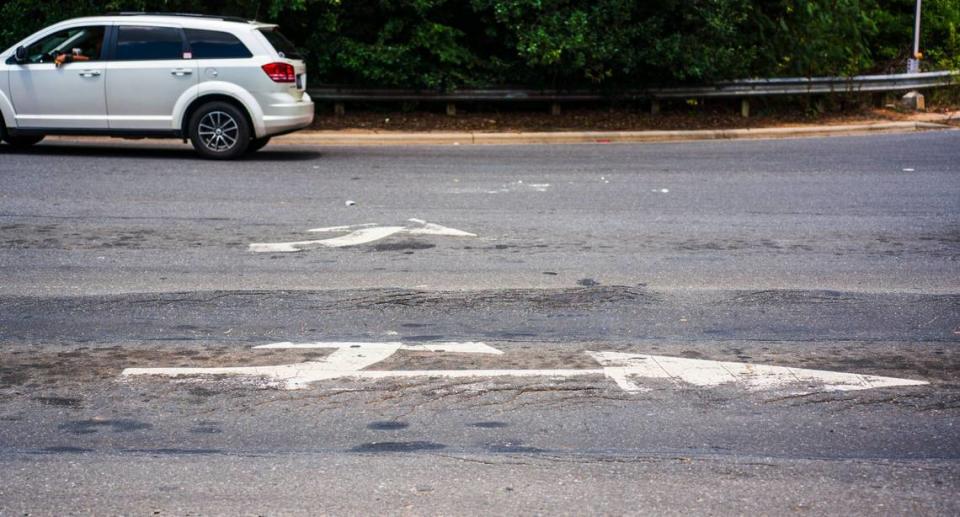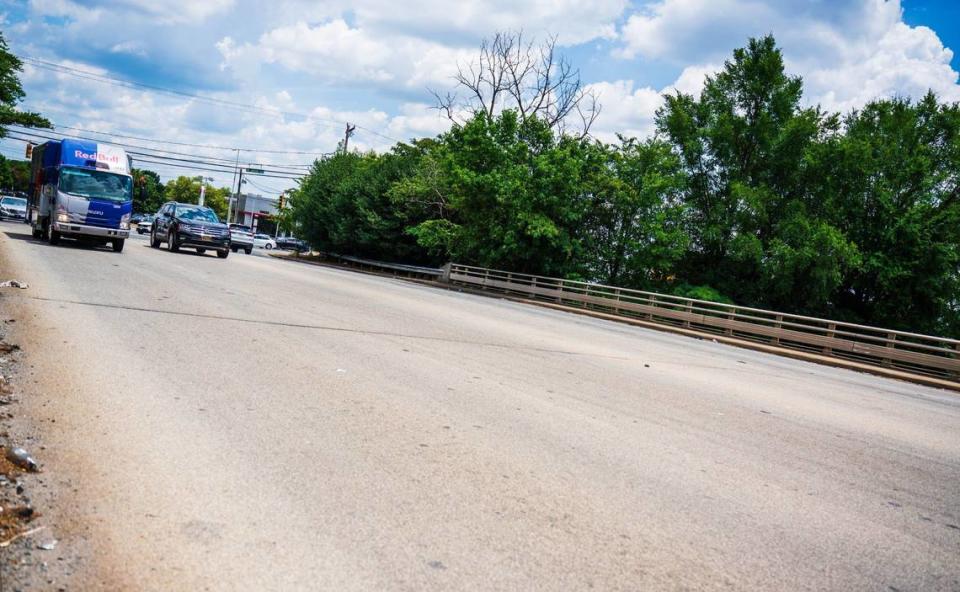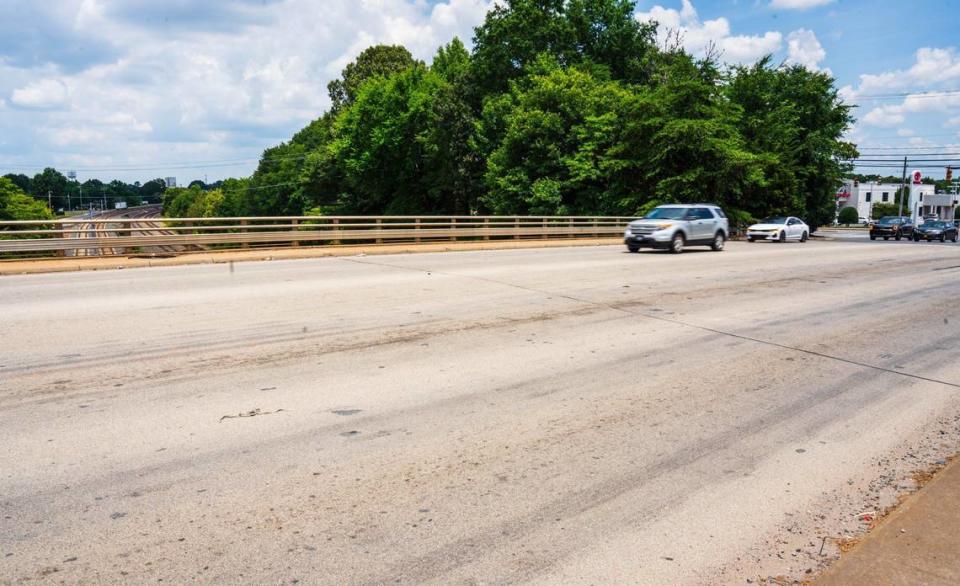Invisible lanes: Why DOT says there’s no easy solution to common NC road problem
Rain lashed against Sarah Richardson’s windshield as she drove her son home from soccer practice on I-485 one October evening last year.
Straining to see through the downpour, the once-crisp white lines that separated lanes on the road became blurry streaks.
Richardson gripped the steering wheel of her blue Hyundai a little tighter and kept her eyes on the taillights in front of her. It was a familiar 25-minute route home, but the rain seemed to swallow everything whole.
Suddenly, she felt a thud against her son’s door. The car lurched violently from side to side. Instincts kicked in, and Richardson fought to regain control. The tires screamed on the slick pavement.
In the mirror, Richardson saw she side-swiped the door of another vehicle. The driver was shaken but unharmed. Richardson unknowingly crossed into the man’s lane.
“It was the scariest moment of my life,” she told The Charlotte Observer. “I didn’t know what had happened, and by the time I realized it, it was too late. I thank God no one was hurt.”

Richardson’s story isn’t uncommon across the Charlotte region. Hundreds of drivers shared similar struggles with The Charlotte Observer: day or night, rain or shine, faded or not, lane markings are hard to see or completely absent.
Rear-end collisions, side-swipe accidents and run-off-the-road crashes are all more likely when drivers can’t see lane markers according to the Federal Highway Administration. More than half of fatal and serious injury crashes in N.C. involve lane departures, according to the Roadway Safety Foundation, an organization that works to reduce fatalities and injuries attributed to roadway conditions.
State and city officials say they are aware of the problems and working to solve them. However, any changes will take years to fully implement.
Invisible at night?

Ann Reynolds drives Billy Graham Parkway at least once a week, often at night.
“The road lines on the stretch between Boyer Street and the entrances to I-85 north and south have faded to the point of almost being invisible, especially at night,” she told the Observer.
Interstate 485 “is a joke” from near York County to Matthews, said Fort Mill resident Blake Scottfield. That’s where crews are building toll lanes between I-77 and Independence Boulevard.
“It seems that the road construction just paints over the old lines,” he told the Observer. “When they wear down or crack, the old lines show through. My car’s lane alert system goes crazy.”
Donald Young drives to and from work in uptown four times a week. He told the Observer that Charlotte may be one of the worst places to drive after dark because of faded and non-reflective lane markings as well as a lack of street lights.
“I fear for every driver on the roads,” Young said.
The science behind lane markings
The North Carolina Department of Transportation usually marks lanes with thermoplastic paint.
Thermoplastics are fused to the asphalt with heat and contain tiny glass beads that act like mirrors, reflecting headlights back toward drivers during dark conditions. The markings last about 12 years, roughly five years longer than traditional roadway paint, but that varies based on traffic volume and weather.
They are effective if they haven’t faded away. A study conducted by NCDOT found that thermoplastic paint led to a 13% reduction in lane-departure crashes.
However, thermoplastics have a weakness: wet weather.
Rain can make the glass beads invisible to drivers by covering them in water and causing headlights to bounce in many directions other than back to the driver. Snow and wear and tear can also damage the beads and reduce their effectiveness.
This makes it nearly impossible to see when it rains, said Zachary Gardner, a traffic engineer for NCDOT. He says there isn’t an immediate solution.
“Of course when it rains it’s going to be harder to see. If the markers are faded too, and the sky is darker, those are all compounding factors that create problems.” Gardner said. “We are pushing to get raised lane markers so drivers feel the lanes but that is going to take time and money.
“Regardless of the weather though, if you can’t see the lanes because they have worn down so badly, it’s going to be dangerous.”
Normal lane markings are significantly cheaper compared to thermoplastics, costing anywhere between a quarter to a tenth of the price.
However, normal paint lasts for only about a year before needing to be repainted. That leads to more frequent road closures and costs associated with repainting or, without maintenance, a total lack of lines and other road markings.
Challenges of road repair

To prevent lane markings from disappearing, transportation departments, including Charlotte, are prioritizing thermoplastics because the markers last longer.
Still, fixing the roads takes time and resources.
Charlotte’s department of transportation maintains 2,500 miles of roads within city limits. NCDOT maintains state and federal highways and other major roads outside of city limits.
While Charlotte resurfaces approximately 140 lane miles annually, more than 400 roads need some form of pavement maintenance according to CDOT’s latest survey of roads. All those roads can’t be repaved because of other projects that would damage new asphalt, according to the city.
Paving also costs about $123,200 per lane mile, with expenses doubling for a two-lane road. This year, the city will receive a little over $13.5 million from the state for roadway improvements, which comes from gasoline taxes collected by the state.
“The city identifies any maintenance needs that can be corrected with patching activities or other repairs that preserve the pavement and maintain satisfactory ride quality until a later date,” a spokesperson said. “This coordination allows the city to maximize resurfacing dollars while maximizing pavement life.”
In June, NCDOT awarded a $1.9 million contract for improvements to sections of 10 secondary roads in Mecklenburg. Work includes milling, resurfacing, shoulder reconstruction and pavement markings.
Still, Richardson says the city isn’t doing enough.
“They are spending money on new stadiums and buildings and not doing the basics of keeping residents safe,” he said.
Other solutions
Transportation departments nationwide are testing new methods to enhance lane visibility and prevent accidents.
Texas is experimenting the use of rumble strips along lane markings. These textured strips create a vibration when drivers drift from their lane, providing an audible and tactile cue in addition to visual guidance. They can be found on the shoulder of many N.C. roads, too.
In Utah, $26 million has been earmarked for updating freeway lanes with tiger tail striping. The lanes have the familiar white dashed line and will be followed by a black line. Supporters say it enhances lane visibility by making it more discreditably for drivers.
Some European countries and Australia have experimented with glow-in-the-dark lane markings, but the technology is still under development and hasn’t been widely adopted.
Tips for driving in the rain
Charlotte residents are encouraged to call 311 or utilize the CLT+ app to report concerns about roadways.
NCDOT also offers the following tips to keep safe on wet roads:
Slow down and allow more time to reach your destination
Be ready for sudden stops or changes in road conditions
Allow at least twice the normal following distance in between vehicles
Signal for turns and brake earlier than usual
Turn on your headlights when using your windshield wipers
Use your defroster to increase visibility


